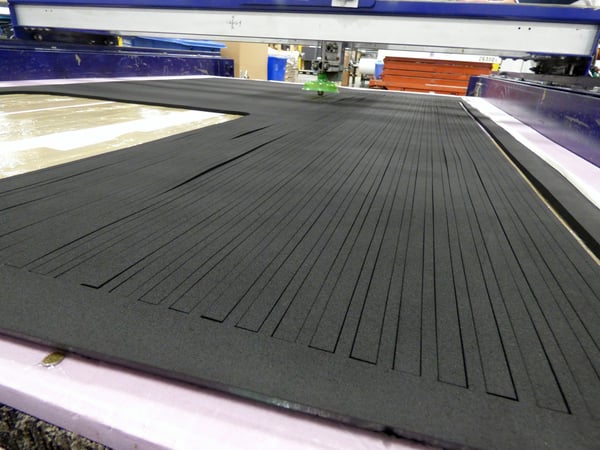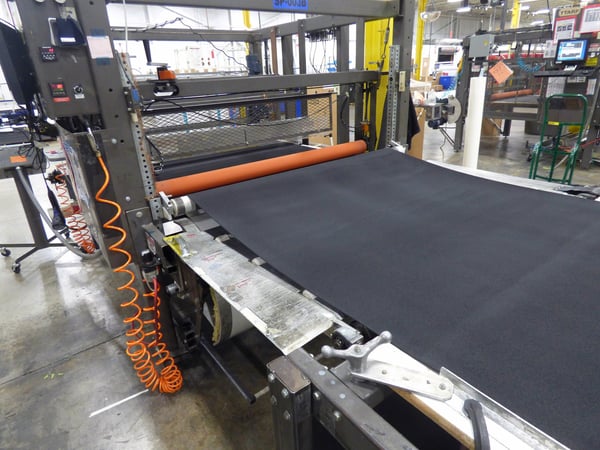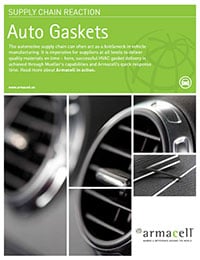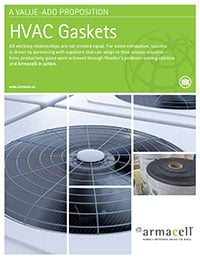
When you manufacture a product, you want it to be durable and work efficiently. However, factors like heat and noise can affect your product negatively. 
Two materials that are used to solve these problems are polyurethane foam and polyester non-woven materials. Both material types have properties that make them well-suited for thermoacoustic applications, but knowing the right material to choose can be difficult.
In this guide, the material experts at Mueller are going to break down everything you need to know about polyurethane foam, non-woven materials, and how the two compare.
What Are the Main Types of Open-Cell Polyurethane Foam?
There are two main types of open-cell polyurethane foam: ether-based and ester-based. These foam types are used mainly in acoustic applications, but can also be used for thermal insulation or moisture and dust sealing applications.
Some of the defining properties of open-cell polyurethane foams include compressibility, insulative qualities, and non-conductive nature. Polyurethane foams are also generally inexpensive, making them a great choice if you need large quantities for production. Ether-based foams also have increased durability to moisture and UV rays.
Polyurethane foams can also have their thickness, density, acoustical facings, and surface texture tuned to cater to your needs specifically. Having some degree of specialization is important when looking at different applications.
.jpg?width=512&name=unnamed%20(9).jpg)
What Kind of Non-Woven Materials Compare to Polyurethane Foam?
“Non-woven” is an umbrella term that covers numerous fabric material types. For this guide, we’re going to focus on polyester non-wovens, as this type most directly relates to polyurethane foams for thermoacoustic applications.
One of Mueller’s trusted business partners, L&L Products, has developed a PET-based vertically lapped non-woven fiber product that is tuneable to customer’s needs. This material can be precisely adjusted to cater to any acoustic or thermal requirements a customer may need, making it one of the most unique and widely used materials on the market.
The vertically lapped structure of this material helps it to maintain loft over the lifespan of a product. Loft, which is similar to thickness, is important for maintaining sound reduction properties. It is important to remember here that not all non-woven materials are vertically lapped, meaning you should always inquire about the structure of the non-woven material you choose.
This non-woven material also dries very quickly, making it ideal for applications where the product might be exposed to moisture.
Like polyurethane foam, this PET-based non-woven also is used in thermal and sound insulation applications, mainly in the automotive industry. The material is found in products like generator sets and commercial vehicles.
How Do You Decide Between Foams and Non-Wovens?
There are four key factors to keep in mind when deciding between polyurethane open-cell foams and PET non-wovens in thermoacoustic applications.
First, you need to understand the acoustical and thermal targets of the product. Once you know what requirements your material needs to hit, you can narrow down the materials to choose from. After narrowing down materials, you can examine other relevant properties like moisture resistance. Once you’ve done that, you can look at optimized solutions based on the problem you’re solving.
In the end, whatever material you choose will be based on your application. However, there are a few factors to consider that might help you make a decision.
Differences Between Polyurethane Foam and PET Non-Wovens
While both polyurethane foam and L&L’s PET-based non-woven are designed to meet thermoacoustic needs, some key differences separate the two.
One of the most significant differences is the lifespans of the materials. Foams will last months, or maybe even a year, before degrading past usefulness. The PET-based non-woven material, however, can last multiple years without degrading. This makes it crucial to consider the environment of the application your material will be used in.
Non-wovens, in general, also have a higher continuous heat operating temperature than foam materials. If your application includes prolonged exposure to heat, polyurethane foam can degrade at a significantly higher rate than polyester non-wovens.
The degradation issue applies to moisture exposure, as well. A wet non-woven material will dry quicker and last longer than a foam material, as well as having a lower odor. If the application includes someone being close to the material, scent can be an issue.
While both material types have a degree of tuneability, PET non-wovens have much more flexibility and range for specification. This is largely due to the science involved, as it is much easier to adjust a fiber blend than it is to alter the chemistry of a foam.
When it comes to cost, polyurethane foam is usually the cheaper option when compared to non-wovens, though the cost is determined on a case-by-case basis.

What Material Should I Use?
While both polyurethane foams and non-woven materials can solve for thermoacoustic issues in various applications, the specific requirements you need met are going to drive your decision.
In many products, foam is the material of choice simply because it’s what customers are used to. After all, foams have been around for decades, while non-woven materials are a relatively newer technology that not everyone is familiar with.
When making your decision, be sure to consider the environment the material will be in, the thermal and acoustic requirements you’re solving for, and the problem you’re trying to fix. Making the right choice can extend the lifespan of your product and enhance the user experience, so it’s crucial to make sure you consider all elements. With this guide, you have the knowledge to do so.





